Redwood Creek has changed throughout time. Its once natural free-flowing state became managed and manicured in the 1920s and 1930s. By the 1970s the environmental era had arrived and ideas on how to manage and protect natural resources were changing.
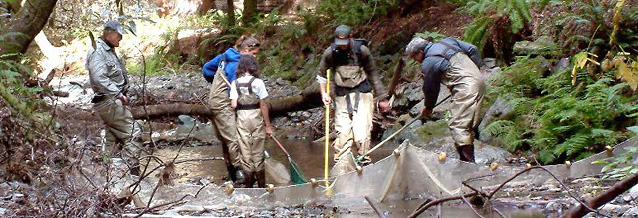
NPS
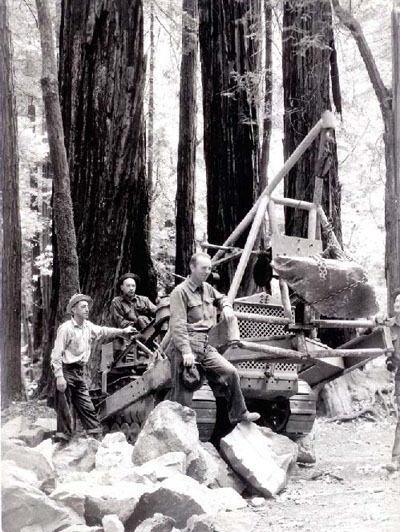
As you walk along Redwood Creek, notice moss-covered rocks lining the bank. These are the remnants of a channel constructed in the 1930s by the Civilian Conservation Corps (CCC) to prevent flooding. With the arrival of the CCC came many changes both helpful and harmful. Fences were built to keep out cattle from local ranches. Native shrubs and ferns were planted to help heal the scarred landscape and deter people from cutting across steep slopes creating more erosion. Trails were improved. Benches, signs, comfort stations and new bridges were installed to accommodate the increasing numbers of visitors.
Between January and March of 1934, 135 truckloads of rock were quarried one mile south of the monument and brought into Muir Woods to create revetments (structures placed on banks to absorb the energy of incoming water) and check dams along the creek to control flooding. The effort to prevent damage from flooding in the park disturbed the natural lifecycle of an important yearly visitor. Salmon would get trapped behind the dams or caught on the rocks. By March of 1936 2,690 square yards of revetment had been constructed and was considered to be only 75% completed.
Time Line
>> 1940s—In California, naturally spawning coho salmon number between 200,000 and 500,000.
>> 1970’s—Several years pass without salmon sightings in Redwood Creek.
>> Early 1990s—California’s population of naturally spawning Coho falls to 10,000 - 15,000. Coho have been extirpated from 50% of the streams they once inhabited.
>> October 1996—National Marine Fisheries Service (NMFS) lists California’s central and southern coho populations.
>> April 1997—The northern California/ southern Oregon population of Coho salmon listed as “threatened” under the federal Endangered Species Act.
>> May 1999—Critical habitat designated for all California coho salmon.
>> January 2000—NMFS releases ‘Conservation Guidelines’ for California salmon and steelhead.
>> June 2005—NMFS lists California’s central coast coho populations as endangered.
>> 2007—Big Lagoon Restoration Project undergoing Environmental Review.
By 1938 most work was completed. In 1941 stacked log revetments were constructed under some of the bridges. With the channel straightened, the creek increased its speed and fast-moving water washed away many riparian plants and spawning gravel. Streamside vegetation is essential. Its shade keeps the water cool, overhanging leaves drip moisture into the stream, leaves and leaf-eating insects drop off into the water, feeding birds, fish, and arthropods. The creek was also cleared of any woody debris which provided much needed shelter and habitat for young salmon.
From 1953 through the early 1980’s, Muir Woods management made a shift towards ecological management. Many of the structures that were built by the CCC in the park were either removed or replaced. Development was removed from within the forest and visitor services were relocated to the southern outskirts of the park. Although the rock and log revetments were never removed from the creek, nature is once again reclaiming Redwood Creek.
The National Park Service and Redwood Creek Nursery continue to help Redwood Creek reestablish its natural meandering course with occasional deep pools by strategically placing logs and woody debris in the creek; restoring historic flood plains by removing levees; and actively encouraging the amount and diversity of streamside vegetation. When rocks fall from the creek walls they are left to be swept down stream by the strong currents of the winter flows. When trees fall across the creek they are left to provide habitat and shelter for future generations of coho and steelhead. Salmon are finding the waters of Redwood Creek a much safer and more hospitable environment in which to return.
Saving the Salmon Species
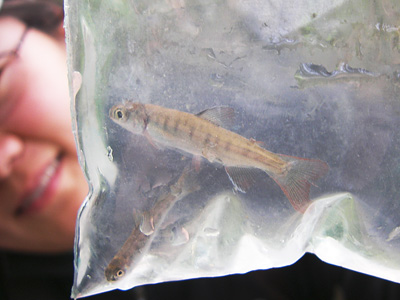
Michael Reichmuth / NPS
Coho (silver) salmon are born and live for approximately 16 months in fresh water as juveniles then migrate to the ocean to grow into adults. They live part of their life at sea before returning home, at the ripe old age of three years, to their natal fresh water streams to spawn.
Coho have been inhabitants for centuries along West Coast streams and rivers ranging from Central California north to Alaska. In the 1940’s along California’s coast the coho population was estimated to be approximately 200,000 to 500,000. In just 50 years the population declined roughly 90% to approximately 10,000. More than 106 native Pacific salmon stocks are now extinct, and 214 more are at risk of extinction.
Causes for the decline in coastal coho population include degradation of habitat due to loss of stream-side vegetation, filling of wetlands, decline in water quality of small streams, dams, fishing pressures, unfavorable ocean conditions, adverse competition from hatchery-grown coho salmon, and inadequate regulatory mechanisms.
Coho are dependent on cool, clear, sustained flows and the stable structural elements of streams in old-growth forests such as Redwood Creek at Muir Woods National Monument.
Redwood Creek is one of the only creeks where salmon have not been stocked or re-introduced. Salmon and steelhead you see swimming before your eyes are truly an ancient strain of salmonids. They are genetically unique from salmon in other creeks in northern California. Although Muir Woods National Monument is a safe haven from human disturbance, they continually face natural challenges here as well as human and natural challenges outside of Redwood Creek.
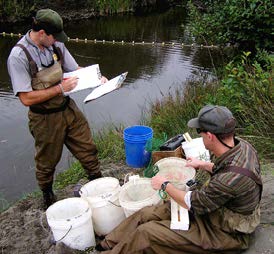
NPS
Biologists continue to survey Redwood Creek watershed yearly to monitor the health and status of the endangered coho. Their research helps management make critical decisions that will ensure a safer environment for the salmonids. You too can help this ancient species, and other salmonids continue their journey safely back home to their natal waters for future generations. Find ways to reduce your water usage. Consider volunteering your time to help protect your local watershed. To learn more about salmon and ways you can help them, visit one of the web sites below:
https://www.nps.gov/rlc/pacificcoast/coho-steelhead.htm
https://science.nature.nps.gov/im/units/sfan/monitor/coho_steelhead.cfm
http://www.parksconservancy.org/get-involved/volunteer/drop-in-programs/park-stewardship-marin.html
Coho Salmon Bio
Alias: Oncorhynchus kisutch; occasionally goes by the name of silver salmon
Known Hangouts: Locally can be found in the Redwood Creek, Lagunitas, San Geronimo and Nicasio creeks watersheds. However they are also known to swim the high seas covering a range of 100 miles south of the United States of America/Mexico border north to the Bering Sea off the Alaskan and Russian coasts and south along the Russian coastline to Japan.
Time to shine: Salmon can be found in Redwood Creek year-round. December–January adults can typically be seen. January–March eggs are hatching. April–December juveniles rule the creek.
Likes: Although it loves the salty waters of the ocean where it spends its time growing big and strong, its first home is in the clear, cool, freshwater creeks and rivers where it is born and ultimately returns as an adult to have its young and end its journey in life.
Dislikes: Excessive silt deposition, flooding, droughts, deforestation, erosion, dams, toxins, birds (such as great blue herons, kingfishers, and mergansers), raccoons, garter snakes, predacious aquatic arthropods, river otters, steelhead, rainbow trout, sculpin, bass, and Orcas. This is just a taste of what dangers lurk around every corner for the coho salmon.
Dinner preferences: Upon hatching, the tiny fish (also called Alevins) are on a strict diet of yolk sac but as they grow so does their hunger. While in the freshwater they eat insects and other food that is available. However after approximately 16 months of freshwater food they will head for the sea and their diet expands to squid, crustaceans and small fishes!

NPS
Sizing up the salmon: Although they start out as an egg in 16–18 months they grow to 5–6 inches and then head out to sea. With their new diet in the ocean environment, salmon can grow over one millimeter per day for a year. By three years of age when they return home to their natural stream, they have grown to 7–12 pounds and up to 24 inches in length!
Sharing the Creek
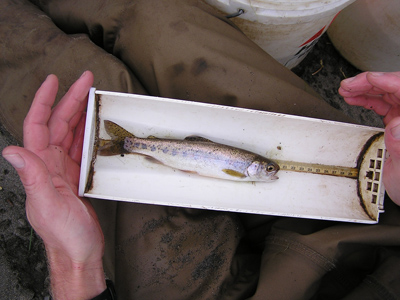
Sarah Koenen / NPS
Also found in Redwood Creek are threatened steelhead trout which is a salmonid. Like coho salmon they return to Redwood Creek to spawn. Look for the adults in January - March. However, unlike coho, steelhead may live in the creek 2-3 years before heading out to sea to reach adult size and return to spawn. Also unlike coho that begin and end their lives here, steelhead will return to sea after spawning in the creek and may return to the creek in following year/s to spawn again.
Prepared by Muir Woods National Monument, 2007.
Last updated: September 15, 2016
